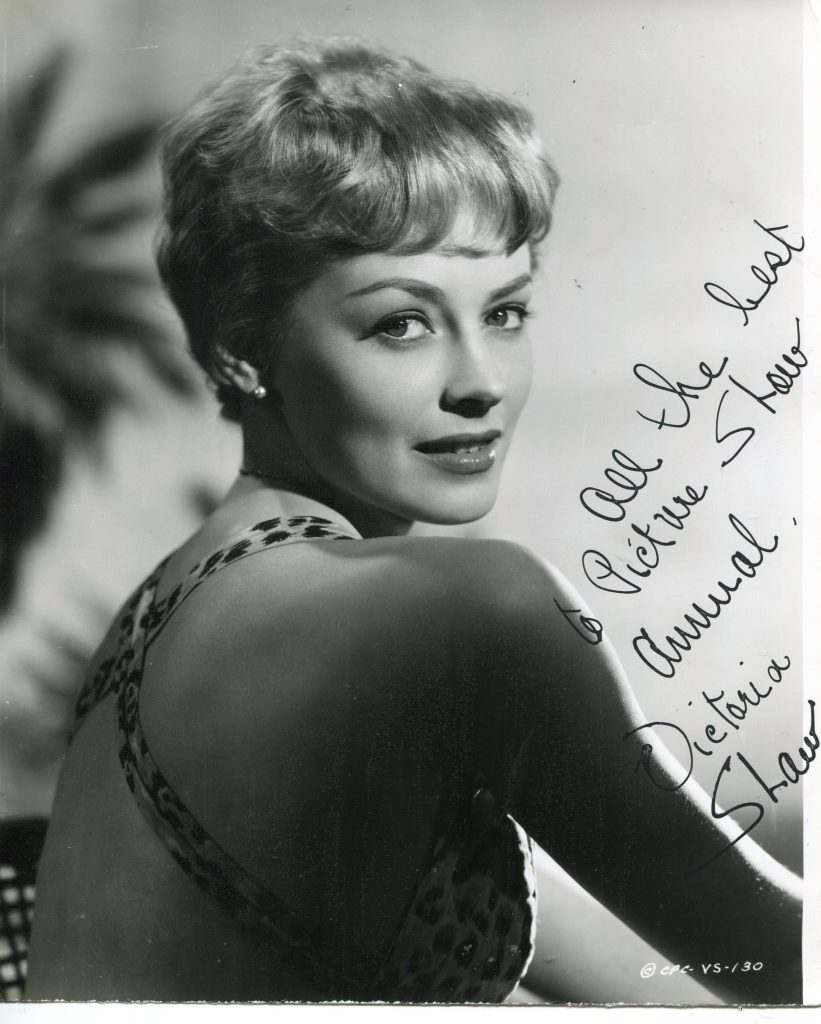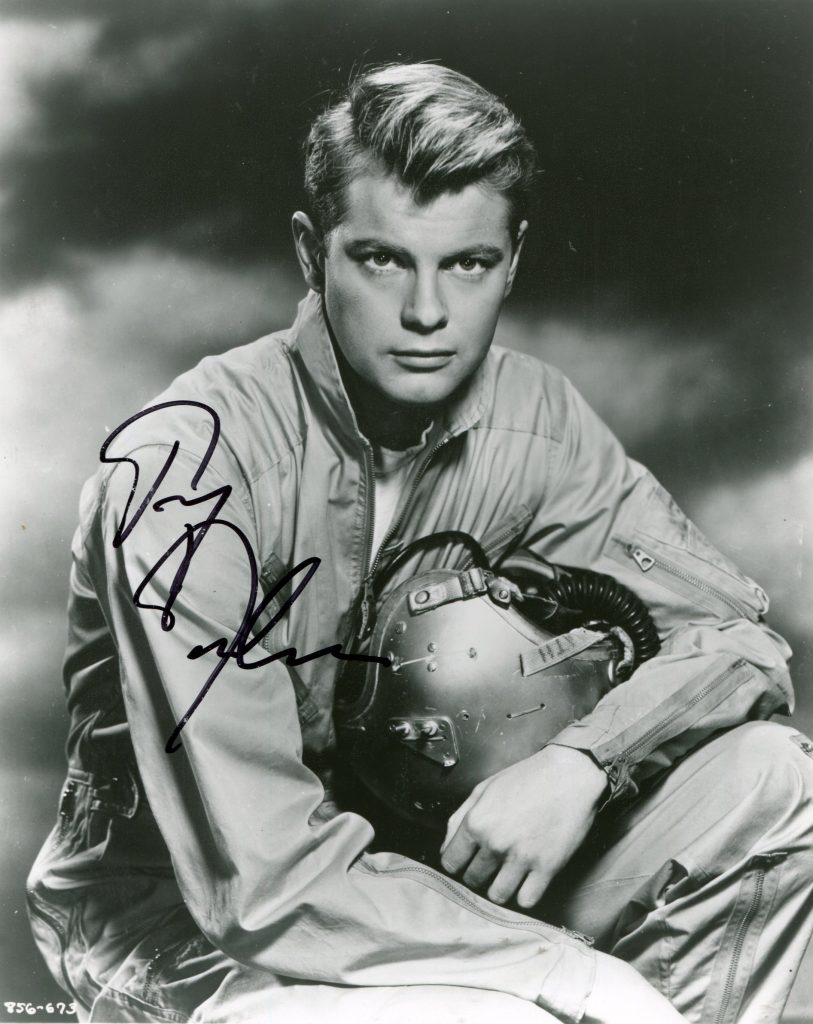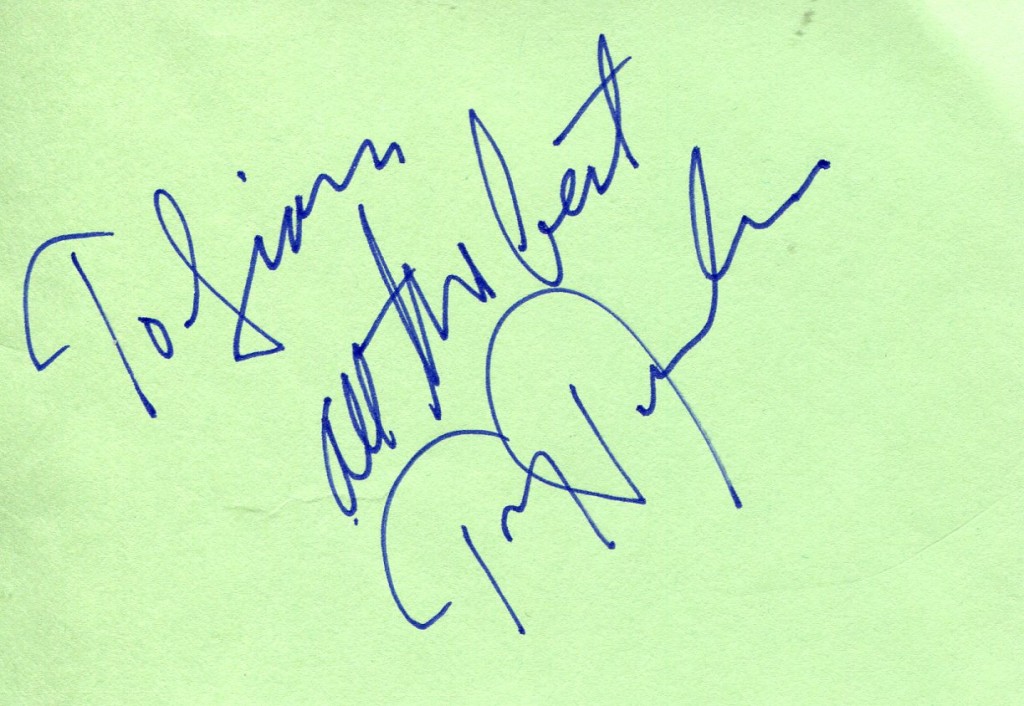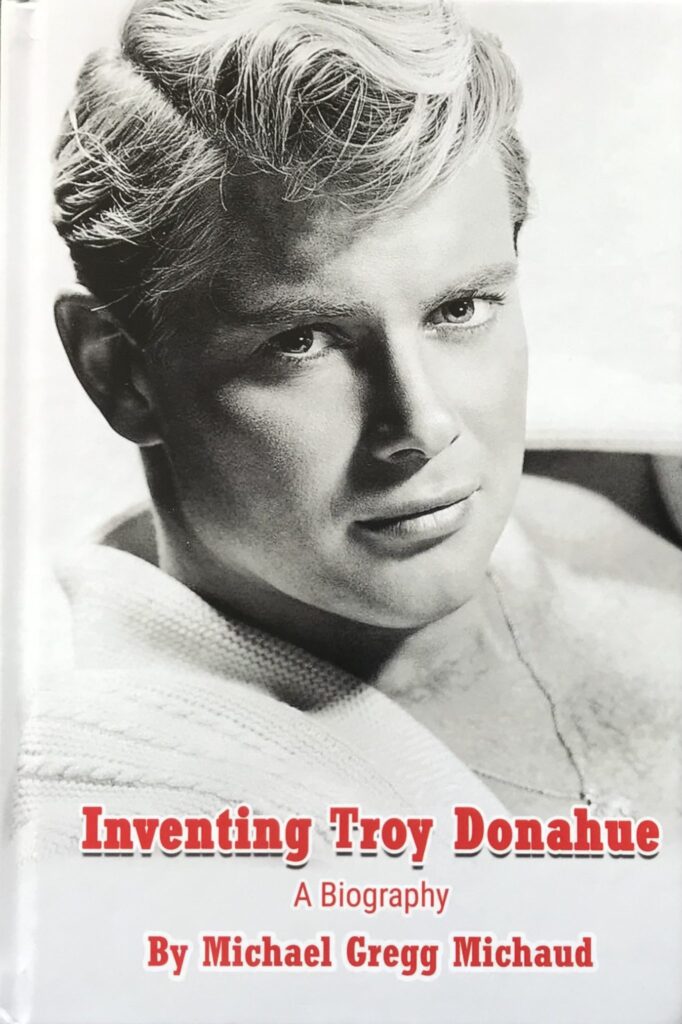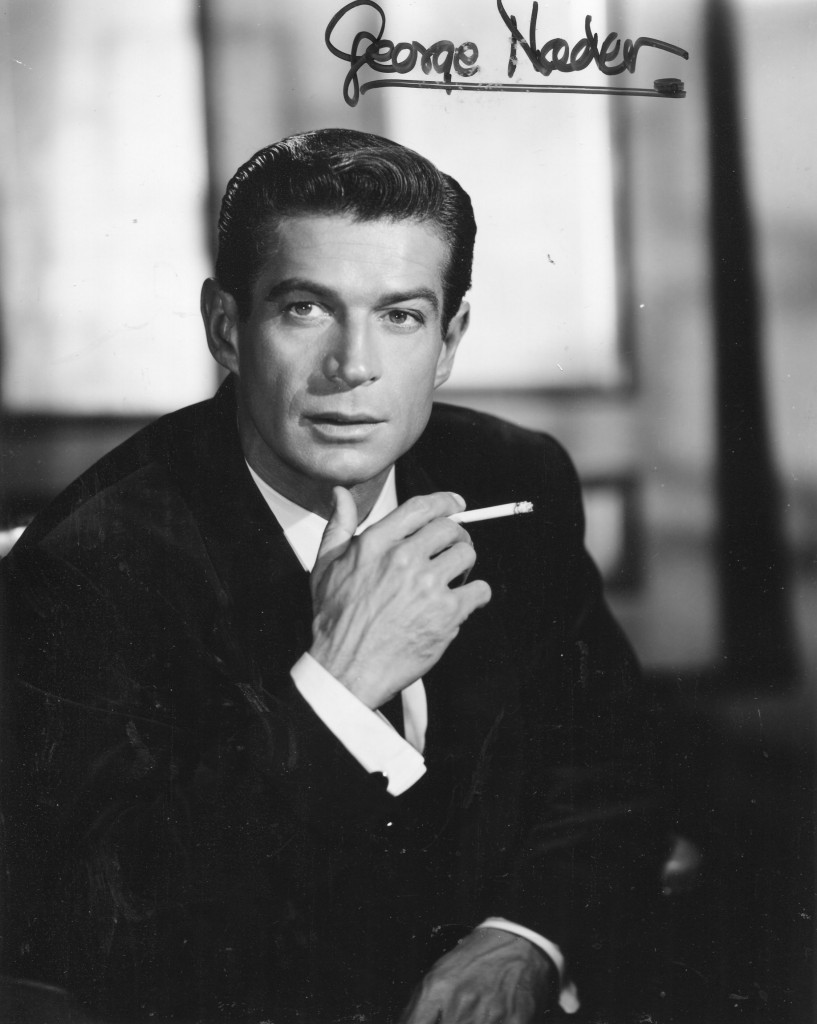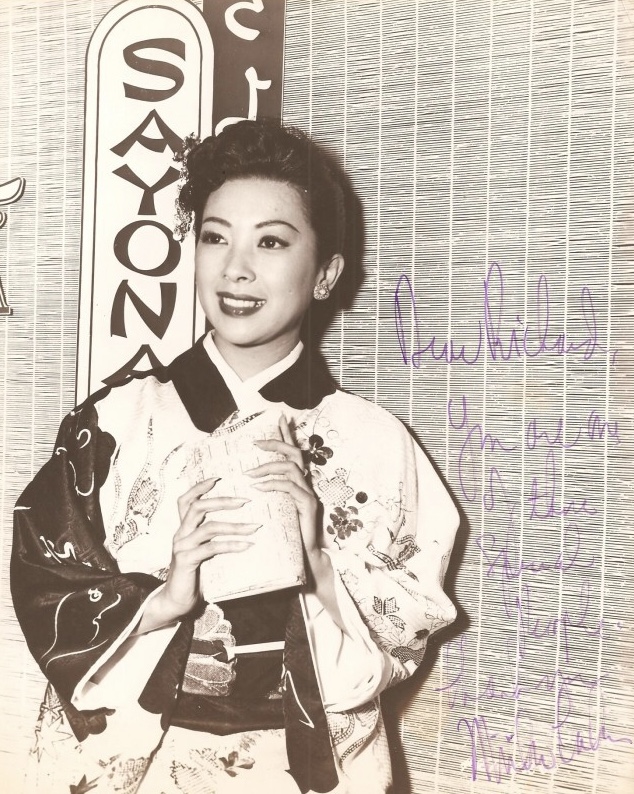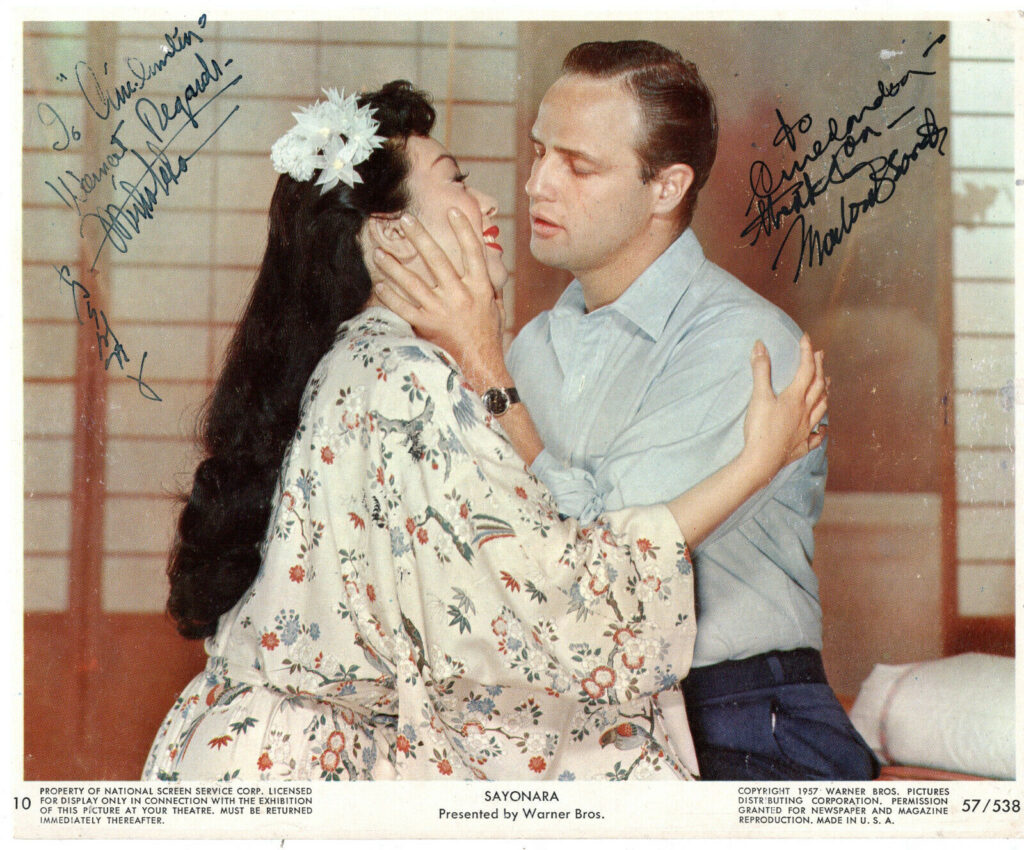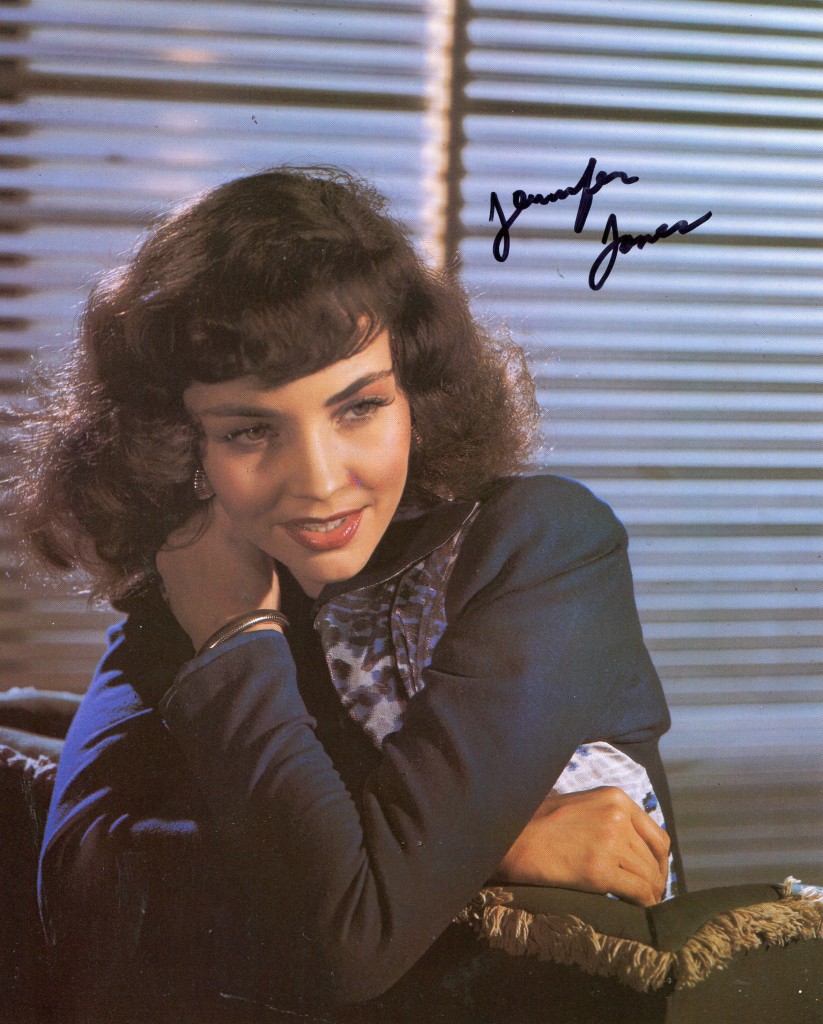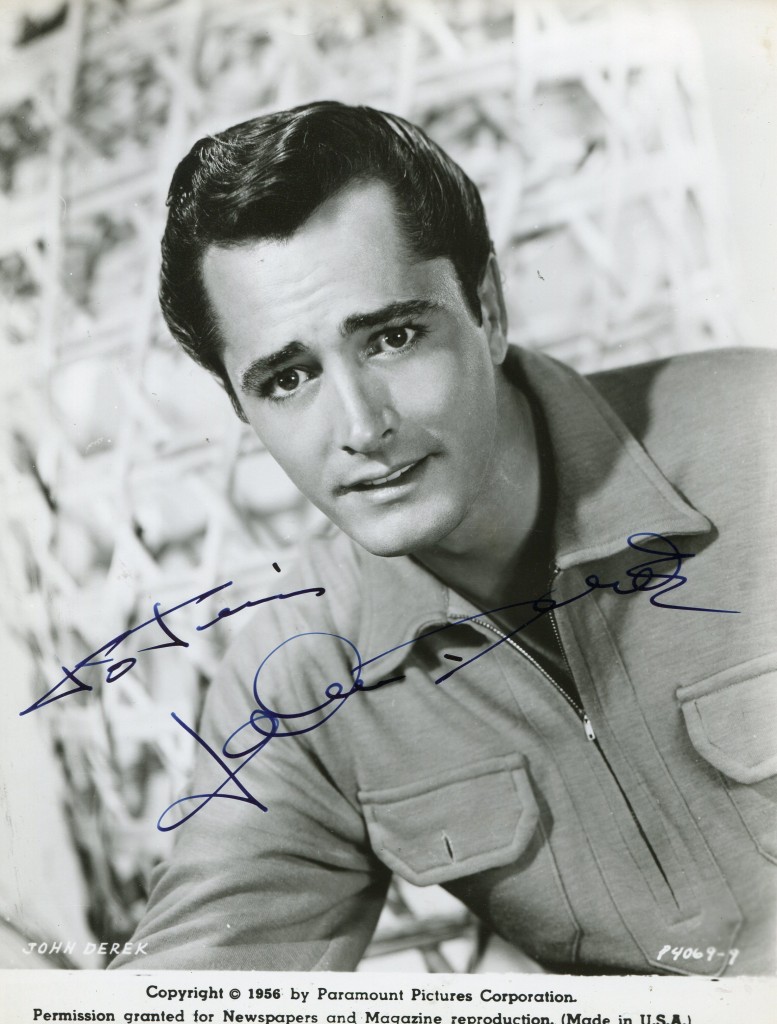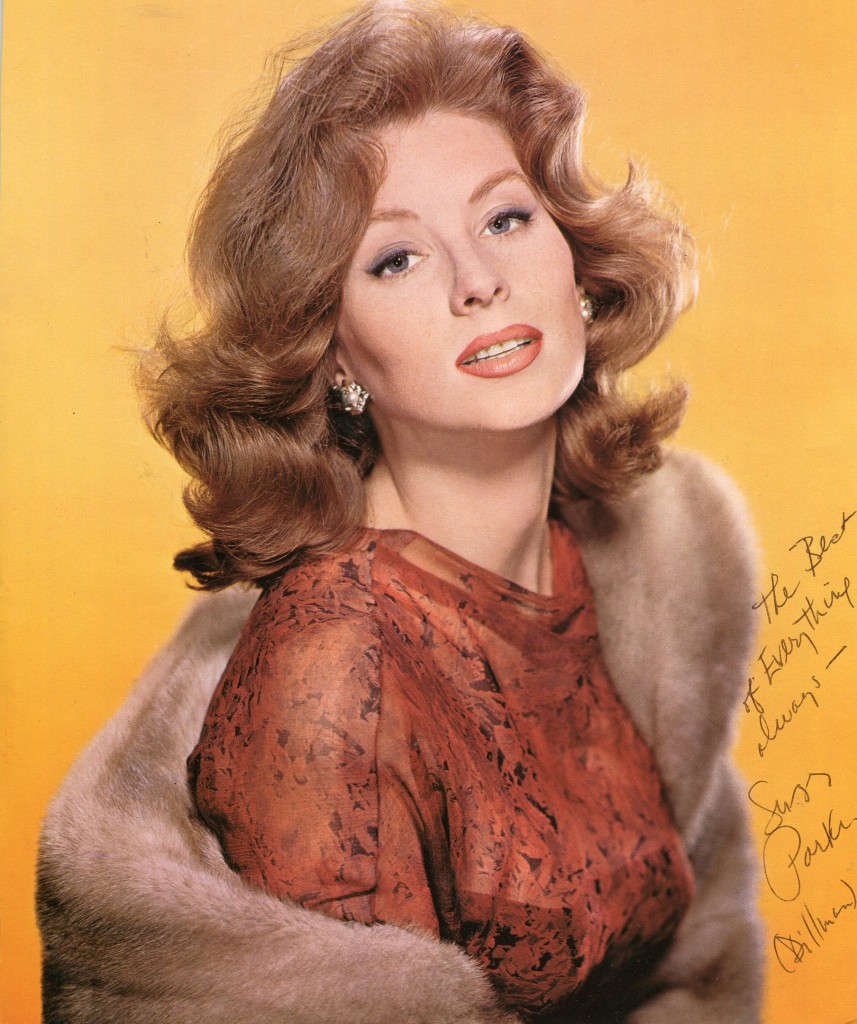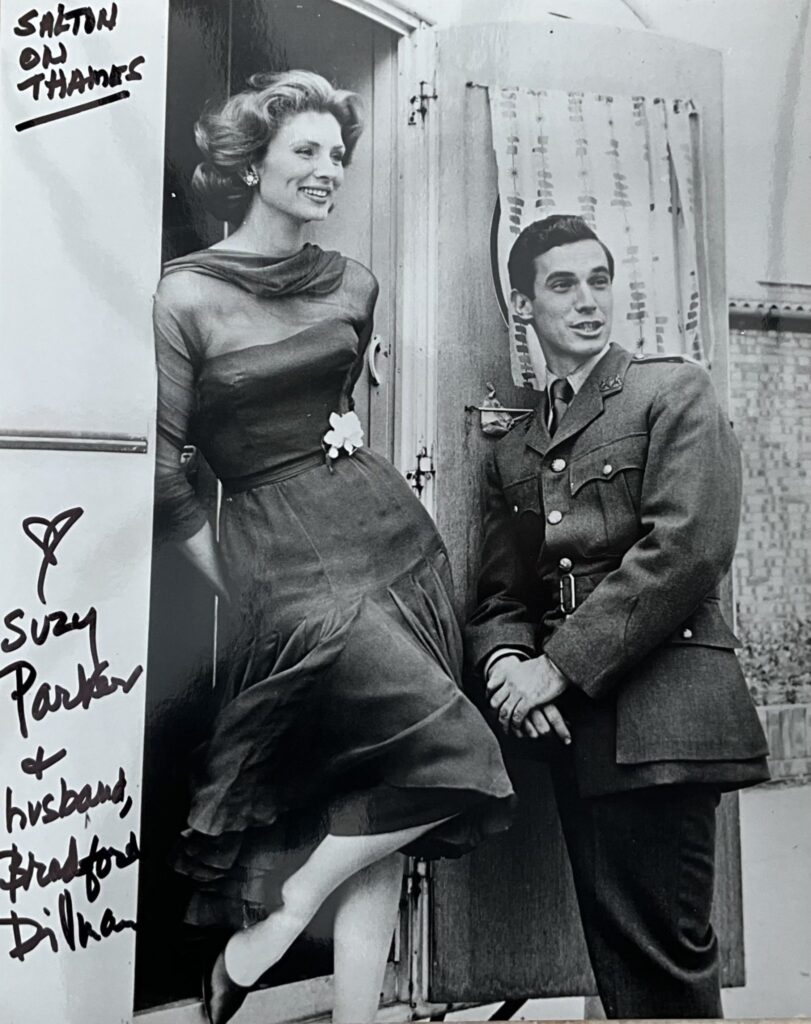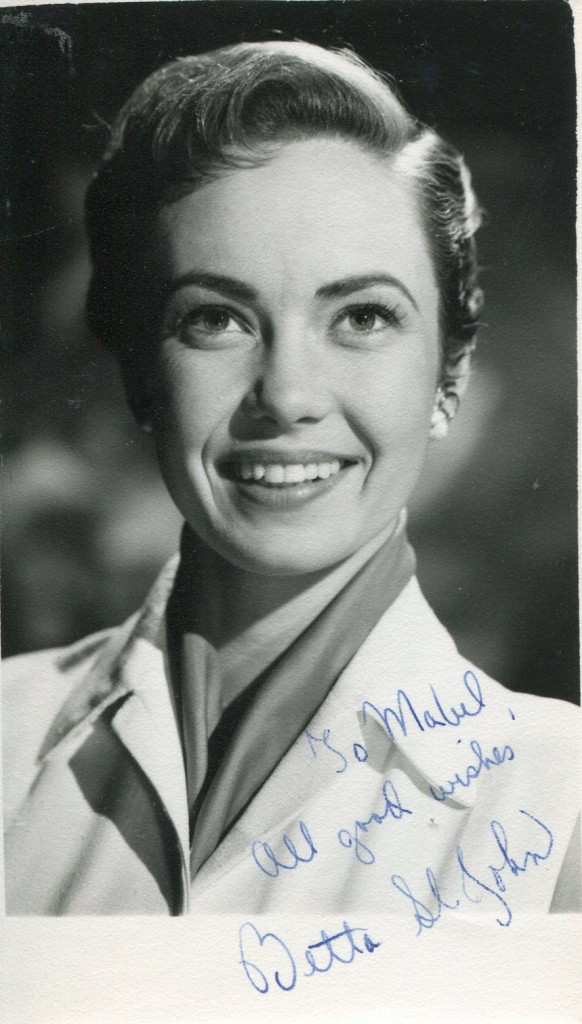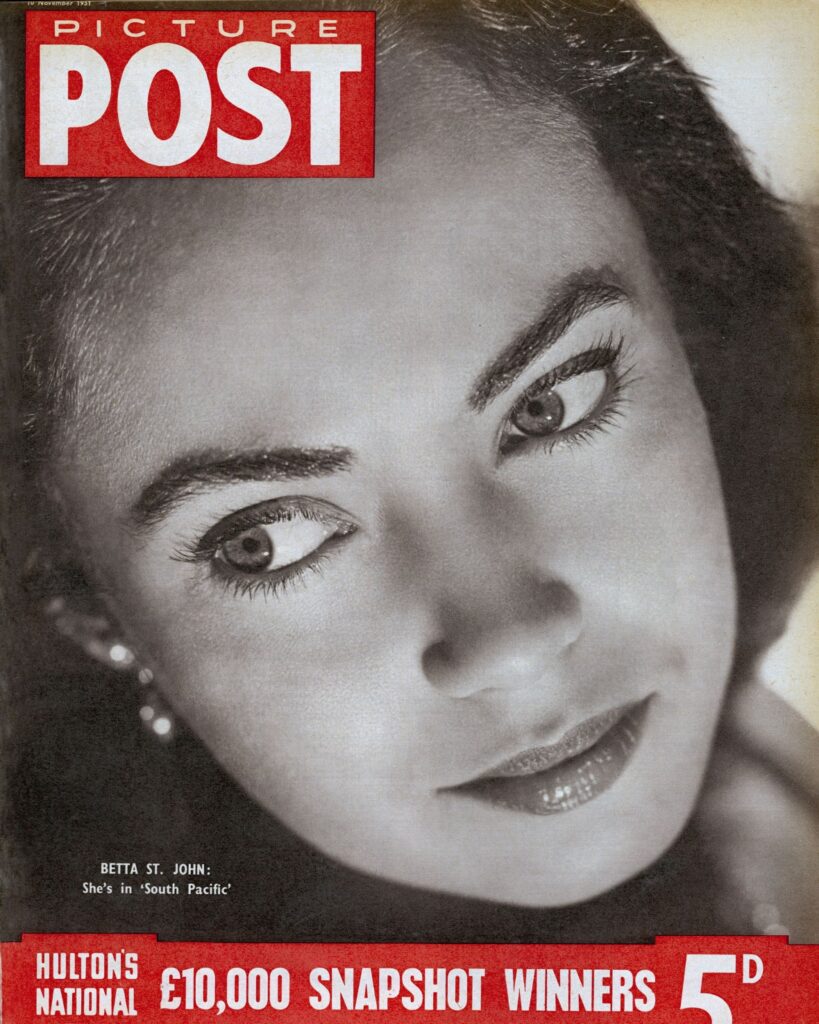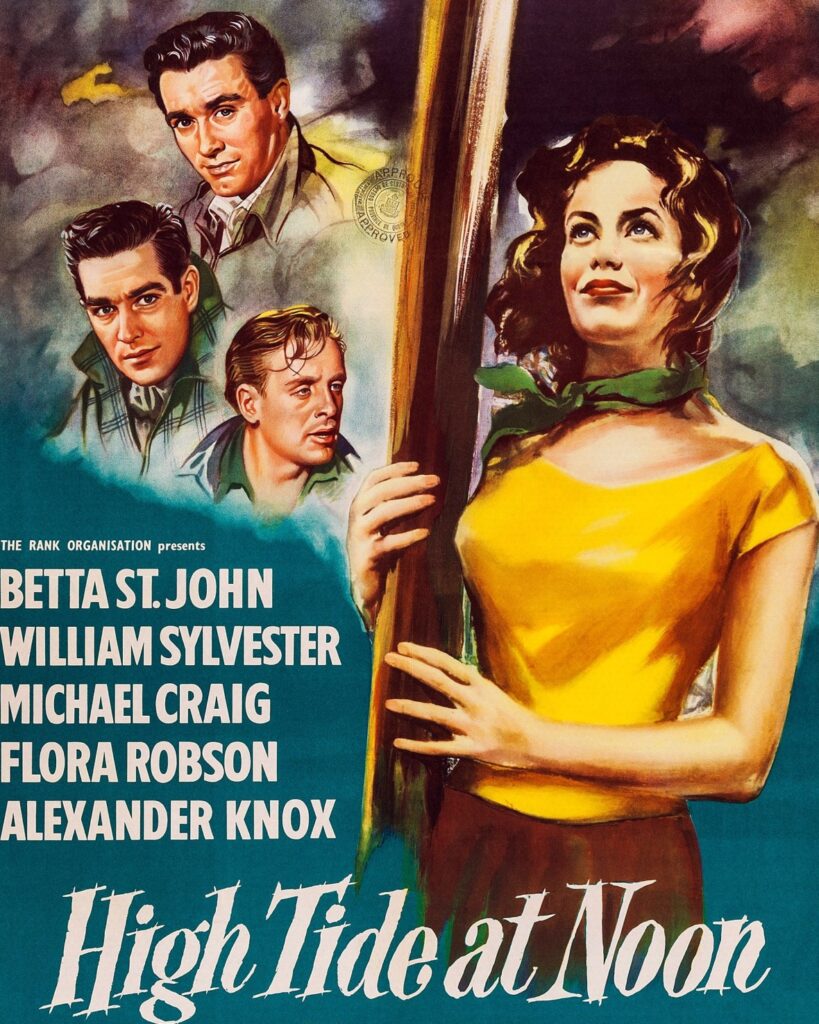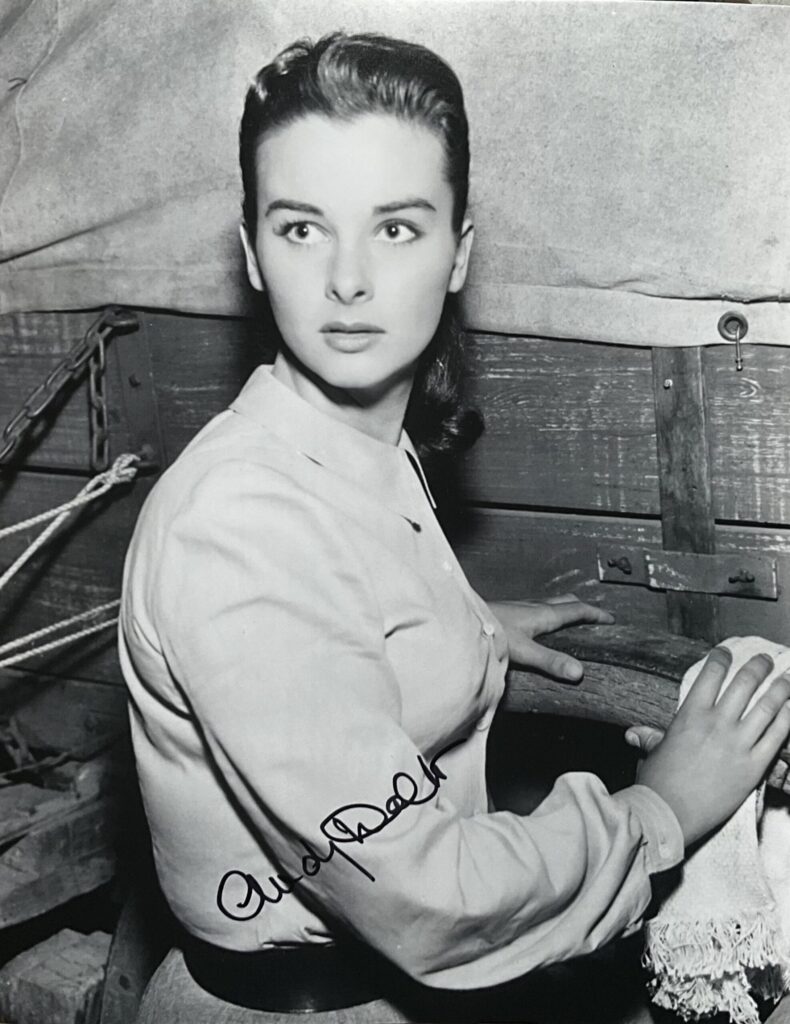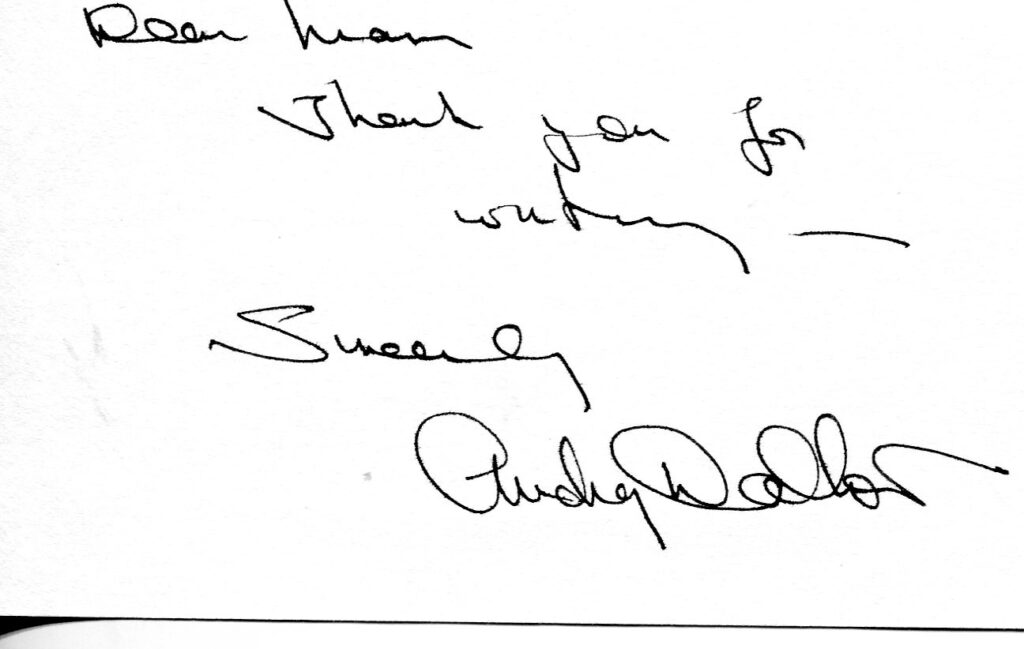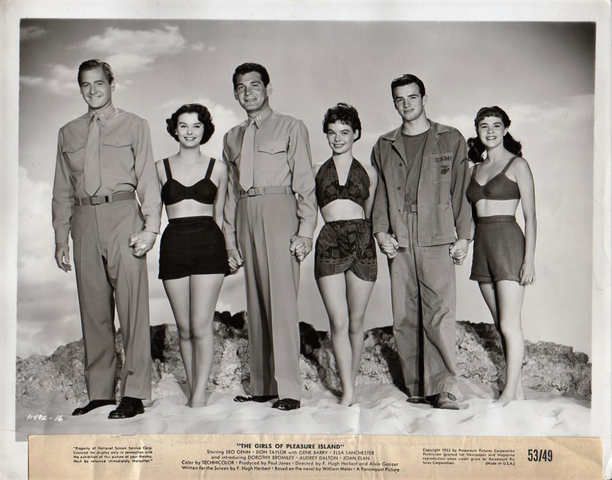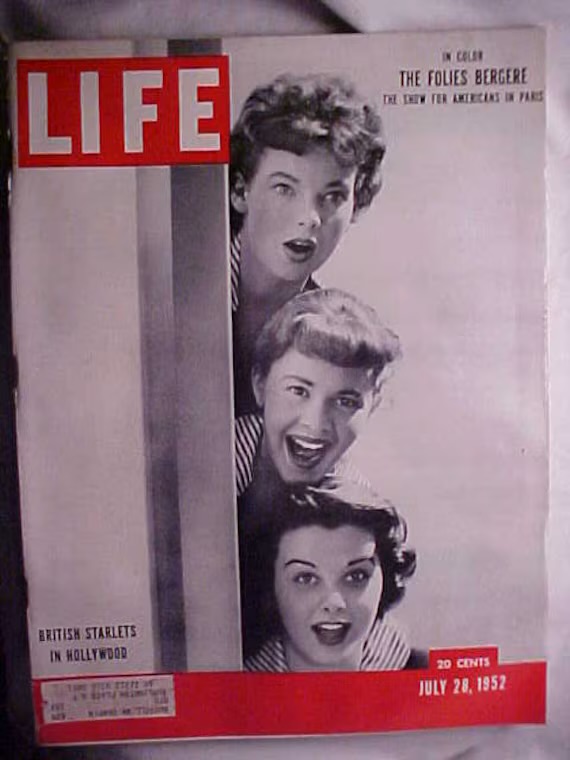Working with Burton and de Havilland in our scenes together was different. The atmosphere was a little uptight as the quiet de Havilland made clear the scene was hers, as she measured up to Burton. They were so different from each other. He was all noise and banter, fun and bluster, and oh, that voice! I was so impressed to be working with him on his first Hollywood film and he seemed to know how shy and overwhelmed I was. He went out of his way to try to draw me out and talk to me when we weren’t shooting.
“De Havilland was always courteous to me and professional and I continued to be in awe of her. She had such control of her work and never displayed any nervousness. The crew’s respect for her apparent.
“My Cousin Rachel was also the first of many times in my career where I had to ride a horse, and sidesaddle at that. I don’t think my fear showed! In spite of all the Westerns I did later, I continued to be very wary and scared around horses.”
Reporters were struck by Audrey’s resemblance to Joan Bennett, and some readers wrote to movie magazines asking if she was Bennett’s daughter. This caused further confusion when Bennett’s real-life daughter, Melinda Markey, had a small part in Dalton’s next.
Later in 1952, Dalton was loaned out again to Fox to play Annette, daughter of Richard and Julia Sturges (Clifton Webb and Barbara Stanwyck), in Titanic (she beat out Terry Moore and Margaret O’Brien for the role). Based on one of the major news events of the 20th century, the sinking of the British luxury liner, director Jean Negulesco’s film bases a lot of its Oscar-winning story (pre-iceberg) on the wealthy Sturges family: Richard and Julia’s marriage is in trouble, and Annette falls for another passenger, handsome young college student Gifford Rogers (Robert Wagner). But the latter couple’s romance is “suddenly split asunder” (Spokane Chronicle) when the “unsinkable” Titanic fails to live up to its hype and, as the closing narrator puts it, “passes from the British Registry.” Regarding her on-screen parents, Dalton told journalist Nick Thomas in a 2016 interview that Webb “was very funny with a sharp wit,” and Stanwyck “a dream—the ultimate pro, always prepared and ready to help.”
There is a certain similarity, Dalton noted, between the fictional characters in her Titanic and the 1997 megahit directed by James Cameron: “The family that was ‘dysfunctional,’ so to speak, the love affair with the young man and so on. Even the opening sequence of the family arriving at the boat, the flurry of the passengers and everything, was just so similar to the beginning of [the 1953] Titanic. …I thought the dialogue in the new one was just inane. But it’s a fascinating picture, no question. And what a success! Of course, now people say about me, ‘She was in the original Titanic,’ and I have to stress the in, not the on!” she laughs.
On January 1, 1953, teenage Audrey and UCLA student James Brown, 22, wed in Los Altos, California. They kept the marriage a secret until that May. Brown later became an assistant director.
Finally making a second movie for her home studio Paramount, Dalton joined the cast of the Bob Hope comedy Casanova’s Big Night (1954). “Joan [Fontaine] was very effervescent and a great match for Bob Hope. They just traded barbs all the time and laughed and joked,” Audrey told interviewer Rick Armstrong in 2016. “It was fun. On the set, he always had the same group of small-part players with him. He knew all these people and would make sure that they were included somewhere in his movie so they always had a job. He took care of people. He was very, very sweet. In fact, when I first came [to Hollywood], I was 18 and on my own. He had a son and a daughter, who were a little younger than me by a couple of years. On Sunday evenings, he would sometimes take me to dinner with his wife. They would come pick me up and take me to dinner because they figured I needed a little looking after. He and Dolores were kindness itself.”
Casanova’s Big Night is one of Hope’s funniest films. Dalton has little to do except look gorgeous playing the lady that Hope, masquerading as the great lover Casanova, has been paid to romance, to test her virtue as her marriage to Robert Hutton looms. She wore a dress made of genuine Honiton lace that belonged to one of the last czarinas, a granddaughter of Queen Victoria. “The dress cost over $1000 and weighed 56 pounds! And I’m presuming the $1000 was what Paramount paid when they purchased it for their wardrobe department,” Dalton said. “Studios had huge wardrobe collections in those days.”
In October 1953, Dalton and Richard Allan (from 1953’s Niagara) won first place for Best Newcomers in Photoplay’s “Choose Your Stars” awards. The ceremony took place at the Rodeo Room of the Beverly Hills Hotel, with Barbara Stanwyck acting as emcee. According to Dalton, she was “very pregnant” at the event; and that same month, she gave birth to her first child, daughter Tara—just weeks after the filming of Casanova’s Big Night! Apparently, most people involved with the production had no idea of her condition. (Dalton points out: “The costumes helped.”)
“Why should people know?” she remarked at the time. “The wardrobe people knew, but nobody else did until I told them.” A few months later, she reflected on her career for interviewer Philip K. Scheuer: “More has happened to me in the past two years than I’d ever dreamed possible. …I have made four pictures, toured Korea and the United States, married and had a baby.
“I had wanted to act on the stage and was very determined never to do films. It’s amazing what happens when you’re offered a film contract!” Dalton today says that at that time, she liked the fact that she could work for perhaps a week on a TV episode, perhaps four weeks on a film, “and then be off for a while to take care of and have time with my family. This is why I never did a TV series and why after I had children I did not go away on location—except maybe to London or Dublin, where I had family.”
After leaving Paramount, Dalton’s first film as a freelancer began shooting in early June ’54: She was leading lady to Alan Ladd in the Western Drum Beat (1954), made by Warner Bros. and Ladd’s company Jaguar Productions. Delmer Daves wrote and directed the story of renegade Modocs threatening to break a peace treaty in the Oregon-California territory. Location shooting took place in Sedona, Arizona, where the cast “sweat[ed] it out in the 115-degree heat” (Star Press). Miami Daily News reviewer Herb Kelly ribbed Ladd, claiming he “shows some real tenderness in his love scenes with Audrey Dalton. Instead of the robot-like smooching he usually does, he’s more hep … especially in a night scene in the woods with Miss Dalton.” As an Eastern girl smitten with Ladd, Dalton gave her customary lady-like portrayal; Marisa Pavan, as an Indian girl also in love with Ladd, has a more colorful and active role in the proceedings.
In 2016, Dalton remembered Ladd as “wonderful to work with—very professional. He was very quiet off the set, very much a gentleman. I knew his family in Los Angeles. My father had known Alan because they were both into racehorses. When I came here [to California], Alan was asked to keep an eye on me. He took me into his family. He had a daughter who was a student at UCLA and she and I became good friends. We’re still friends.”
She was signed by MGM for The Prodigal, a $5,000,000 “wannabe epic” based on the Bible story of the Prodigal Son; it was adapted by Samuel James Larsen, a cerebral palsy sufferer who lived in a hospital and typed with a pencil in his mouth. Lana Turner starred as the temptress Samarra and Edmund Purdom played the title role, with Dalton as Purdom’s shy betrothed. Modern Screen summed this one up pretty well: “Wait till you dig Lana in those bugle beads! She is a real-life goddess for whom young men willingly dive into a pit of fire. And when Edmund Purdom spots her, he says goodbye Poppa (Walter Hampden) farewell Ruth (Audrey Dalton) hail Samarra (that’s Lana) I’m your slave.” Unfortunately, the movie gave Audrey very little to do.
Right after The Prodigal wrapped, Dalton went to England for writer-director Ken Hughes’ Confession (1955), a “punchy” (Banbury Guardian) crime thriller involving a bank heist, murder in a confessional, and a family torn apart by a more modern Prodigal Son (Sydney Chaplin). Dalton makes a good showing as Chaplin’s “charming and ingratiating sister” (Kinematograph Weekly) whose slow realization that he’s a crook and murderer causes her much anguish (or, as the Birmingham Daily Gazette says, she “goes all broody”). Confession, called The Deadliest Sin in the U.S., was a “money-spinner overseas” (Kinematograph Weekly), doing smash box office. Dalton followed this with the John Payne Korean War movie Hold Back the Night (1956): In flashbacks, she’s seen as Kitty, a Melbourne girl to whom Payne is attracted out of loneliness (and vice versa). She only had a couple of scenes, but even in her limited screen time, she gives a moving performance as she tells Payne about her husband (she’s unsure whether he is dead or a prisoner of war). “Because John Payne wanted me to play Kitty, I was paid very well indeed for a small part,” Audrey recalled. “Never knew why. Never met him before or since!”
In May 1956, Dalton appeared in her first TV drama, The 20th Century-Fox Hour’s “The Empty Room,” as Carey, a girl determined to prevent the reunion of her father (Patric Knowles) and mother (Virginia Field), who ran out on him many years before. An unimpressed Variety reviewer re-dubbed it “Stella-Dallas-on-the-Thames” and had no use for any of the characters, including Dalton’s “babbling, idiotic” Carey.
With science fiction and horror pictures all the rage, Dalton signed on to make The Monster That Challenged the World (1957) with Tim Holt. “It was presented to me at a time when I wasn’t working. And I always like to work! I was never discriminating with a capital D. I just wanted to work, I enjoyed working. I’ve always felt with those science fiction things that just that one little nugget of ‘well, it could be true’ kind of gets you [laughs]! So, it was fun.” Monster was based on just that kind of true-life “nugget”: A Mojave Desert lake bed, dry for decades, had recently flooded, hatching as many as 4,000,000 long-buried eggs, and soon the newly formed lake was teeming with fresh-water shrimp. Monster’s screenplay made the eggs prehistoric, and the late-blooming mollusks inside grow to the size of small trucks and terrorize California’s Salton Sea area. Dalton, playing a scientist’s secretary at a Navy base, has a dramatic scene in which she emotionally unloads on hero Holt about the recent death of her pilot husband.
Dalton had started at the top, acting with such stars as Olivia de Havilland, Richard Burton, Barbara Stanwyck and Alan Ladd. Asked by Tom Weaver if she felt Monsterwas a step down, she replied, “Of course it was. But I was also just pregnant, and I knew I wasn’t going to be able to work much longer—in those days, once you were pregnant, you couldn’t work. So I thought, ‘Well, let me get another one under my belt while I can!’”
At the end of ’56, she appeared in an episode of Lux Video Theatre, “Michael and Mary,” with Patric Knowles (this time as her husband). Audrey did not return to acting until the following summer and fall, when she did two more Lux Video Theatres (“Barren Harvest” and “Judge Not”), two Bob Cummings Shows (“Bob Hires a Maid” and “Bob the Gunslinger”) and a Men of Annapolis (“Look Alike”).
In between, she filmed two 1958 movies, Thundering Jets and Separate Tables. The former, shot on location at Edwards Air Force Base, had her as secretary Susan, girlfriend of USAF Flight Test School captain Rex Reason. Resentful and “broody” over being assigned as an instructor for novice test pilots, Reason makes everyone’s life miserable, Dalton included. Dalton was ostensibly Reason’s leading lady, but it’s her scenes with the charming Buck Class (as Major Mike Geron) that sparkle. She had a smaller part in director Delbert Mann’s dramatic Separate Tables, based on two Terence Rattigan one-act plays and set in an English hotel. But what a movie and cast to be a part of! The stars were Deborah Kerr, Rita Hayworth, Burt Lancaster and Gladys Cooper, plus David Niven and Wendy Hiller, both of whom won Oscars for their performances in this Best Picture nominee. Dalton, portraying Rod Taylor’s love interest, is not really involved in the main storyline of Niven’s revelation that he has exaggerated his military career, and does shameful things in the darkness of theaters.
In 1958, Dalton’s small-screen credits included two Wagon Trains (“The John Wilbot Story” and “The Liam Fitzmorgan Story”), The Millionaire (“Millionaire Ellen Curry”), Bat Masterson (“The Treasure of Worry Hill”) and Man with a Camera (“Two Strings of Pearls”). Her next film, the post–Civil War Western Lone Texan (1959), starred Willard Parker as Clint Banister, who returns to his Texas hometown and is considered a turncoat because he served in the Union Army. He finds the town overrun by lawlessness—overseen by his own brother, Greg (Grant Williams). Dalton has one of her best roles as a feisty gal who doesn’t know how she feels about Clint’s return. Her part is more energetic than usual as she stands up to the bad guys, slaps them and fights one of them off when he attempts to rape her. When her father is gunned down, Dalton takes matters (and a pistol) into her own hands and confronts his killer.
Back in the old sod, Ardmore Studios in Bray, County Wicklow, Ireland, opened in April 1958, founded by Audrey’s father Emmet Dalton; Emmet and Louis Elliman then became its managing directors. Among the movies shot or partially shot at Ardmore: Shake Hands with the Devil (1959), Dementia 13 (1963), The Spy Who Came in from the Cold (1965), The Lion in Winter (1968)—and the Audrey Dalton–starring This Other Eden (1959). Produced by Emmet, the movie tells of a statue of a local IRA hero, Jack Carberry, being erected in the Irish village of Ballymorgan. The residents pretend Carberry was a saint, but know differently. Conor Heaphy (Norman Rodway), who wants to become a priest, learns that he is Carberry’s illegitimate son and, angered by the hypocritical lies told about Carberry, blows up the statue. Audrey plays his friend Maire McRoarty, who is the object of Crispin Brown’s (Leslie Phillips) affection. Nine days of location shooting took place in the County Wicklow and Dublin areas.
“The idea behind it was to showcase the Abbey Players,” Audrey told interviewer Jim Rosin. “[My father] wanted to make a film of the play This Other Eden and he asked if I would star in it. So I went back and co-starred with Leslie Phillips, Milo O’Shea and members of the Abbey Players. Much of the crew that worked on the film were Irish who had been doing films in England. They were delighted to return home. So was I. It was a wonderful experience. I brought my three children and was able to visit with family and friends.”
As for Ardmore Studios, Audrey told Tom Weaver, “I know it went through hard times a couple of times. In Britain, J. Arthur Rank had a monopoly on distribution, Rank owned all the British theaters and would only release his own productions. Other producers could make films but then have no theaters to release them to. The fight went on for years. Rank eventually lost the fight, but too late for my dad.”
Dalton finished off 1959 with guest shots on Disneyland (“The Griswold Murder”), Wagon Train (“The Jose Maria Moran Story”) and Bat Masterson (“To the Manner Born”). Her TV activity picked up in the early 1960s as she guested on King of Diamonds (an episode partially shot in Paris and London), Dante, The Aquanauts, The Tab Hunter Show, Acapulco, National Velvet, Lock Up, Michael Shayne, Bringing Up Buddy, Whispering Smith, The Investigators, Perry Mason, Checkmate, Bonanza (one of her favorites, as she played a bad girl), Kraft Mystery Theater (as a secretary who schemes with her boss Louis Hayward to kill his wife, Signe Hasso—who is plotting to kill him!), Ripcord, Gunsmoke, Death Valley Days, Wide Country, The Dakotas, Temple Houston, Dr. Kildare and I’m Dickens, He’s Fenster. During this TV whirlwind, Dalton was seen frequently on Wagon Train—six episodes between 1958 and 1964.
“I used to do one every season, and one season they even squeezed me into two. There was that [rule] that you couldn’t do two in the same season, because people were going to confuse you with your other role. Ward Bond liked me—I mean, in the nicest way. It was because I was Irish. He had this thing about Ireland.
“Thriller was the same thing as Wagon Train, I kept getting invited back. When they liked you on a series, you’d get invited back. It was like a stock company, and every year you’d come back. Alan Caillou, Abraham Sofaer, a whole bunch of people would keep showing up on Thriller, and you’d renew acquaintance and get to work together again.”
Dalton recalled the Boris Karloff-hosted horror anthology series Thriller as “a great show” that provided her with some of her best parts. Her first, Season 1’s “The Prediction,” was also Karloff’s first as a cast member in the story itself; he was a stage mentalist who suddenly does have second sight, she was his daughter. Just ten episodes later, in “Hay-Fork and Bill-Hook,” she was the one with second sight: Playing the wife of a Scotland Yard detective, she has inexplicable “visions” in a Welsh village steeped in witchcraft. In Season 2, Dalton excelled at cold-bloodedness in “The Hollow Watcher,” a one-of-a-kind mix of murder drama, sexual tension and backwoods horror, set in a North Carolina hamlet whose folklore includes an avenging, demon-possessed scarecrow. Dalton, the Irish mail order bride of a local yokel (Warren Oates), is actually a money-mad colleen partnered with her real husband (Sean McClory) on a globe-trotting murder tour. Dalton recalled, “Oooh, that was grand! That was a little ‘different’ part for me, too, which was nice. Now and then I played [meanies] … but they were the exception. I was always the nice girl, the ingénue—which was fine, which was…the way I was [laughs]! So it was fun to have something with a little more meat to it, and to be given free rein. [Director William Claxton] let me run with it, which was fun. That hadn’t happened before.”
As if three Thrillers in 15 months wasn’t enough to please the Monster Kids in her fanbase, Dalton also joined the cast of the fright flick Mr. Sardonicus (1961). Nineteenth-century Europe was the backdrop for this bleak horror tale, with Guy Rolfe as a farmer without a farthing, reduced to digging up his father’s coffin to retrieve a winning lottery ticket accidentally buried within. The sight of Dad’s skeletal face is so shocking that the farmer’s own face takes on the same lip-less, toothy grin. Now wealthy enough to re-dub himself “Baron Sardonicus,” he forces Dalton to marry him in order to compel her former beau, London physician Ronald Lewis, to find a medical means of restoring his good looks. Horror producer-showman-huckster William Castle’s gimmick for this production: Just minutes from the end, Castle (playing himself) asks audience members if Sardonicus should receive mercy or no mercy. This of course gave viewers the idea that the theater projectionist had two different finales and would then project the chosen one; but Castle knew that every audience would vote to give Sardonicus the works, and therefore a “mercy” ending was never filmed!
“Every time my acting career seems to be on the way up, I have another baby,” Dalton remarked in 1962. By this time, she had four, Tara (born 1953), Victoria (1955), James (1957) and Richard (1959). In her 2016 interview with Nick Thomas, she said with a chuckle, “What’s interesting is that many websites today have given me a fifth child! He even has a birth date and a name—Adrian. Needless to say, my children have made great fun of it and ask why I never told them about their lost brother!”
Dalton made her last two films in the mid–1960s. For Kitten with a Whip (1964), she phoned in her performance—literally! In her one scene, she phones her husband (John Forsythe) at their home and tells him she will return the next day, unaware that he has entangled himself with bad girl Ann-Margret.
Much better was the Western The Bounty Killer (1965). Filmed in only ten days on a low budget, it featured a wonderfully warm-hearted Dalton as saloon girl Carole Ridgeway—who sings “Go Away Old Man and Leave Me Alone,” dubbed by Harlene Stein. (Dalton wants Bounty Killer fans to know that she was directed to pretend-sing it at an “agonizingly slow pace”!) She falls for the naïve Willie Duggan (Dan Duryea) and they plan a future together. But, when Willie’s friend (Fuzzy Knight) is slain, the lust for vengeance makes Willie a killer. The Bounty Killer received notice for the small role played by Western pioneer G.M. “Broncho Billy” Anderson (his last film), but for Dalton fans it contains one of her most heartfelt performances. Audrey recalled with a laugh that producer Alex Gordon “made me feel like a star—even though I was over the hill by the time I did that.”
Then, it was back to TV in episodes of Voyage to the Bottom of the Sea, Laredo, The Big Valley, Insight, The Girl from U.N.C.L.E., Dragnet 1967 and Family Affair plus the telefilm Me and Benjy (1967). She remembered her Wild Wild West (“The Night of the Golden Cobra,” in which she plays maharajah Boris Karloff’s daughter) as “great because I got to walk two cheetahs on a leash! That was fun, and so were the exotic costumes.” She ended her acting career with a trio of Police Woman episodes in 1974, 1975 and ’78.
After 24 years together, Audrey and James Brown divorced in July 1977. On July 20, 1979, she wed an aerospace engineer, and that union continues to this day. She is popular as a guest at nostalgia conventions and autograph shows. Asked why she drifted away from acting, Dalton replied, “It sort of drifted away from me. It happens. You have to really have staying power, and I didn’t, I guess. I was involved with family, and I just let it drift. If I had it to do over again, I wouldn’t. But I did. One goes on.”
As for life today (2021), she enthuses, “I love being on the ocean and have sailed for over 50 years. Racing boats with my husband is one of my great pleasures. I have been so fortunate, all my life, to be able to continue on. Wherever ‘on’ takes me
